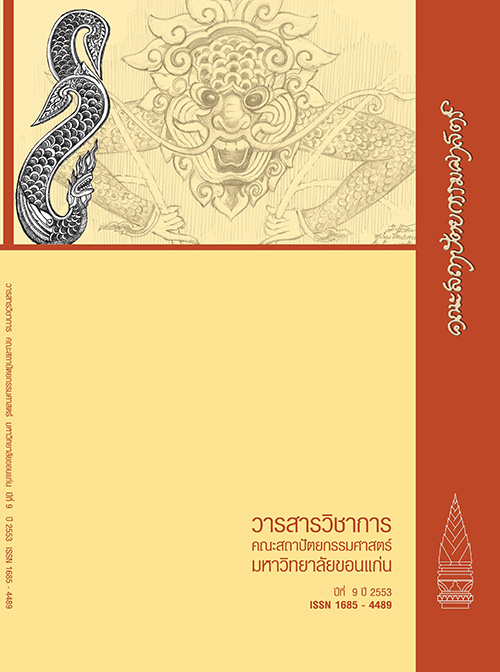การศึกษาโดยการทดลองเรื่อง การเปลี่ยนแปลงของอุณหภูมิและความเร็วลมผ่าน ช่องว่างของหลังคาเหล็กเคลือบโลหะ
คำสำคัญ:
การทดลอง, การเปลี่ยนแปลงอุณหภูมิ, หลังคาเหล็ก, Experimental testing, Change in temperature, Metal roofบทคัดย่อ
งานวิจัยนี้มีวัตถุประสงค์เพื่อศึกษาถึงการลดอัตราการถ่ายเทความร้อนผ่านหลังคาเหล็กรีดด้วยวิธีการระบายอากาศแบบ ธรรมชาติผ่านช่องว่างใต้แผ่นหลังคา เทียบกับหลังคาเหล็กรีดแบบธรรมดาและแบบที่ติดฉนวนความร้อน โดยวิธีการทดลองภาย ใต้สภาวะแวดล้อมจริง ด้วยหุ่นจำลองขนาด กว้าง 0.80 x ยาว 2.00 x สูง 0.70 m. ด้านบนเป็นหลังคาเหล็กรีดมีทั้งหมด 5 แบบ ติดตั้งที่มุมเอียง 10 องศา หันไปทางทิศใต้ แบบที่หนึ่งเป็นหลังคาเหล็กรีดธรรมดาแผ่นเดียว แบบที่สองเป็นหลังคาเหล็กรีดติด ฉนวน PE COOL แนบลอนหลังคา แบบที่สามเป็นหลังคาเหล็กรีดติดแผ่นอลูมิเนียมฟอยล์สะท้อนรังสีความร้อนด้านล่าง แบบที่ สี่เป็นหลังคาเหล็กรีดติดซ้อนกันสองชั้นให้เกิดช่องว่างระบายอากาศ แบบที่ห้าเป็นหลังคาเหล็กรีดติดซ้อนชั้นให้มีช่องว่างอากาศ สูงขึ้นโดยเพิ่มฉนวนโฟมโพลีสไตรีน หนา 50 mm. ระหว่างแผ่น จากผลการทดลองพบว่าหลังคาเหล็กรีดแบบที่ 5 เป็นแบบที่ลด การถ่ายเทความร้อนดีที่สุดในช่วงเวลากลางวัน รองมาคือแบบที่ 4, 3, 2 และ 1 ตามลำดับ เมื่อเทียบกับหลังคาเหล็กรีดแบบที่ 1 หลังคาเหล็กรีดแบบที่ 5 สามารถลดอุณหภูมิใต้หลังคาได้มากสุดร้อยละ 77.33 และประหยัดพลังงานที่ใช้ในการปรับอากาศ มากสุดร้อยละ 60.93 ต่อปี
An Experimental Study of Change in Temperature and Air Velocity Through Metal Roof Cavity
The objective of this study was to reduce heat transfer rate through metal sheet roofs by naturally ventilated cavity compared with a simple metal sheet roof and an insulated metal sheet roof. An experimental testing was set up by building experimental boxes (model size 0.80 x 2.00 x 0.70 m.). The top of the boxes was installed with five different types of metal sheet roof installed at the angles of 10o tilt toward south. First type was a simple metal sheet roof. Second type was a simple metal sheet roof insulated with PE COOL. Third type was a simple metal sheet roof attached with aluminium foil. Fourth type was a double metal sheet roof with an air gab in between the metal sheets. Fifth type was a double metal sheet roof attached with 50 mm. thick polystyrene foam with an air gab in between the metal sheets. The results show that the fifth roof type was the best in reduction of heat transfer through the roof in the day time compared with fourth, third, second and first roof types respectively. The fifth roof type could reduce heat transfer through metal sheet roof by 77.33 % compared with the first roof type which could save energy used by air conditioning system by 60.93 %.
ดาวน์โหลด
รูปแบบการอ้างอิง
ฉบับ
ประเภทบทความ
สัญญาอนุญาต
ทัศนะและข้อคิดเห็นของบทความที่ปรากฏในวารสารฉบับนี้เป็นของผู้เขียนแต่ละท่าน ไม่ถือว่าเป็นทัศนะและความรับผิดชอบของกองบรรณาธิการ




